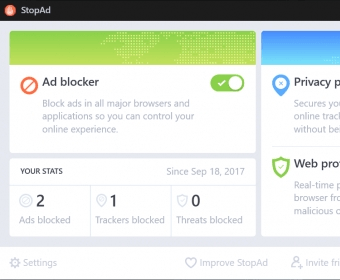

- #Stopad vs adblock install#
- #Stopad vs adblock software#
- #Stopad vs adblock plus#
- #Stopad vs adblock tv#
Elsewhere, mobile browsers including UC Browser, Brave, Opera Mini and Adblock Browser block ads by default. On anti-tracking front, those include Apple Safari with its Intelligent Tracking Prevention feature Firefox’s Enhanced Tracking Protection and Microsoft Edge’s Enhanced Tracker Prevention. Now browsers are offering anti-tracking and ad-blocking features as standard. In the early days, ad blocking was primarily driven by browser extensions.

#Stopad vs adblock tv#
“We’ve proven ourselves - all the numbers show we’re now bigger than TV and print combined - now it’s time to figure out what eggs we broke getting there.” “It’s the inevitable maturation of the industry,” he continued. While not wanting to take the all the credit, Thurman said: “Our standards have had some impact in cleaning up the worst of the worst experiences that really pushed consumers to stop ad blocking.”
#Stopad vs adblock install#
Neal Thurman, director of the Coalition for Better Ads, said the ad blocker install rate on desktop Chrome in North America and Europe has dropped 60% since discussions about forming the group began in late 2016 and the first quarter of 2020. In 2018, Google’s Chrome introduced a filter to automatically block out ads that don’t meet the Coalition’s ad standards. Overseen by law firm Venable, the cross-industry group identified over a dozen intrusive ad formats that the industry should seek to avoid. In 2016, a group of companies and trade bodies including Google, GroupM, Procter & Gamble, the Interactive Advertising Bureau and the World Federation of Advertisers formed the Coalition for Better Ads. (Some publishers even moved to prevent ad blocker users from viewing their content.) And as ad blocking grew in popularity, the digital advertising industry was forced to be more introspective about the types of ads that annoy users. Legislation such as the EU’s General Data Protection Regulation and the California Consumer Privacy Act have forced publishers to be more upfront about the data they collect for advertising purposes and the value users receive in return. Much has changed in the ad industry since Williams ‘ “halcyon days” of blocking in the middle of the last decade. were detected to be blocking ads on mobile devices in 2020, up from 5% in 2018. AudienceProject’s research found just 7% of respondents in the U.S. Mobile ad blocker user growth hasn’t yet been as profound in the U.S. That growth was mainly driven by users in Asia and India - particularly through adoption of the UC mobile browser, which was estimated to have more than 400 million monthly active users at the end of 2019. While desktop ad blocking has declined, mobile ad blocking rose globally by 64% between 20 to 527 million users, according to a separate report released in February from Blockthrough, a company that helps publishers recover revenue lost to ad blocking.
#Stopad vs adblock plus#
There are a few intertwining theories as to why fewer people are using ad blockers on their desktops - ranging from the shift to browsing on mobile devices, to publishers and tech companies asserting more discipline around the display of annoying ads like pop-ups and autoplay videos with sound on.īen Williams, director of advocacy at Adblock Plus owner Eyeo, acknowledged via email that ad blocking on desktop computers has dropped off since the “halcyon days in the summer of ’16” primarily, he said, because fewer people are browsing on desktop computers. In most countries, the sessions blocked on a computer decreased in 20 versus 2020 - though there were slight increases recorded in Germany, Sweden and Finland.ĭata from consumer insight company GlobalWebIndex’s latest quarterly survey of more than 100,000 global participants on average also found those saying they used an ad blocker had declined: To 42% in the second quarter of 2020, down from 49% in the year-ago quarter, 46% in 2018 and 48% in 2017.
#Stopad vs adblock software#
(However, the 2020 number was slightly higher than the 39% of those surveyed who said they used an ad blocker in 2016.) In the U.K., the number of people saying they use ad blockers has steadily declined: 47% in 2016 41% in 2018.ĪudienceProject also attached an ad to the online survey and used its measurement technology to detect whether the respondents were actually using blocking software at that moment. In the U.S., for instance, 41% of respondents said they used an ad blocker in the latest round of the survey - conducted between April and June 2020 - versus 52% in 2016.


 0 kommentar(er)
0 kommentar(er)
